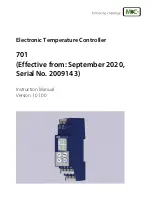
Customer Service Telephone 1.800.304.6563
Customer Service Facsimile 1.800.426.0804
Robertshaw®, Ranco®, Paragon® and Uni-Line® are
trademarks of Robertshaw, its subsidiaries and/or
affiliated companies. All other brands mentioned
may be the trademarks of their respective owners.
For Technical Service
Telephone 1.800.445.8299
www.uni-line.com
www.robertshaw.com
©2015 Robertshaw
08/15 –352-00008-00
6
EXTENDING SENSOR
CAUTION:
Sensor wiring splices may be made external from the control.
CAUTION:
Disconnect power to control before wiring to avoid possible
electrical shock or damage to the controller.
Additional cable can be spliced to the sensor cable to increase the
length beyond the standard 8 feet. It can be extended up to 400 feet.
The cable should be at least 22 AWG or larger to keep additional
resistance to a minimum.
All splices and wire lengths added to the sensor cable should be made
according to acceptable wiring practices and should conform to the
National Electrical Code and local regulations. Use copper conductors
only. Shielded cable is not required. The sensor is not polarity sensitive.
Checkout Procedure
1. Before applying power, make sure installation and wiring
connections are correct.
2. Apply power to the control and observe one or more cycles
of operation.
3. If performance indicates a problem, check sensor resistance
to determine if sensor or control is at fault.
4. To check sensor resistance, disconnect sensor and measure
the resistance across the leads while measuring temperature
at the sensor.
SENSOR REPLACEMENT
Figure 9: Sensor replacement on Display (Upper) Circuit Board.
Sensor Replacement
ETC models are available with Quick Connect Sensor feature that
allows for easy sensor replacement due to damage or wear. To access
the sensor connector, disconnect the power supply and open the
control. Remove single screw located in the center of the Display
Upper Circuit Board and carefully remove Display Board Circuit.
Remove Sensor Strain Relief to allow sensor to be removed from unit.
See Figure 5 for location of sensor strain relief. The sensor connection
is made at the P1 Connector on the Display Upper Circuit Board.
See figure 9 for connection information.
Replacement Sensor - Order
Part No. 1309007-048
Figure 10
SPECIFICATIONS
The 1309007-048 sensor is a negative temperature coefficient (NTC)
thermistor sensor. The sensor resistance decreases with temperature
increase. It is .25 x 1.94 long with 8 feet #22 AWG cable. The thermistor
has a reference resistance of 30,000 ohms at 77°F (25°C).
Deg. C.
Deg. F.
RES. Nom.
-40
-40
1,010,000
-30
-22
531,000
-20
-4
291,200
-10
14
166,000
0
32
97,960
10
50
59,700
20
68
37,470
25
77
30,000
30
86
24,170
40
104
15,980
50
122
10,810
60
140
7,464
70
158
5,200
80
176
3,774
90
194
2,753
100
212
2,036
110
230
1,531
Figure 11:
Resistance vs Temperature of 1309007-048.
Sensor including 8 foot cable.
SENSOR CONNECTOR
























